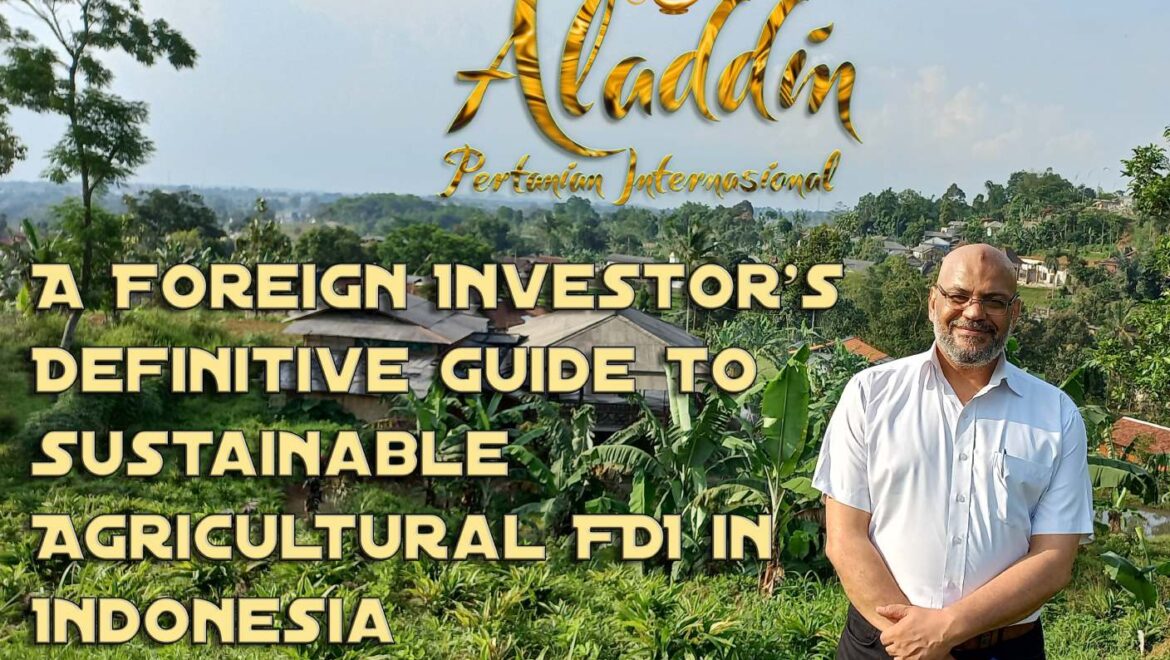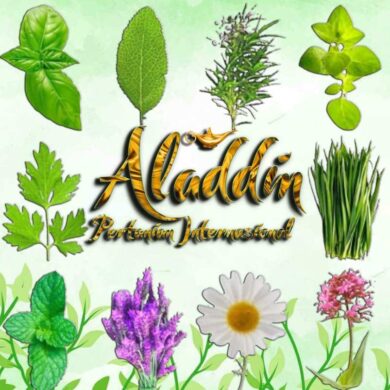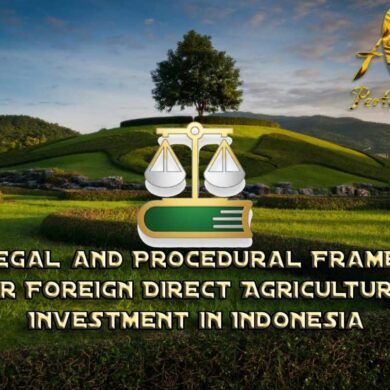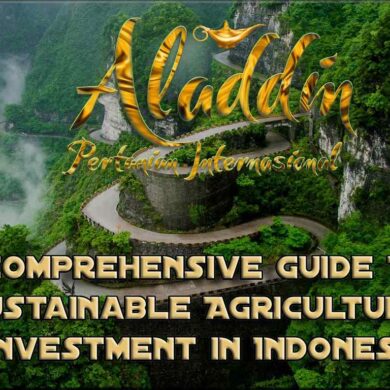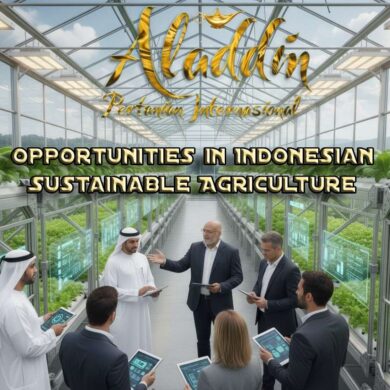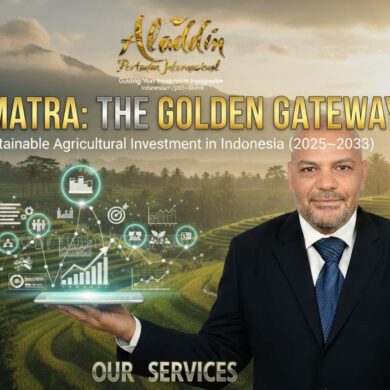The Green Harvest: A Foreign Investor's Definitive Guide to Sustainable Agricultural FDI in Indonesia
I. Executive Summary: The Indonesia Opportunity (2025-2030 Outlook)
1.1 The Strategic Imperative: Positioning Indonesia for Global Food Security
Indonesia, the largest economy in Southeast Asia and the fourth-most populous country globally with approximately 276 million citizens, presents a compelling case for Foreign Direct Investment (FDI) in its agricultural sector.1 This vast domestic market, coupled with a growing middle class, ensures resilient demand for food and value-added agricultural products. The sector remains a foundational cornerstone of the national economy, contributing approximately 13% of the national Gross Domestic Product (GDP) and employing roughly 28% of the country’s workforce.3
Despite modest declines in its GDP share as other industries grow, agriculture is consistently prioritized by the government for its critical role in achieving national food self-sufficiency and driving rural development.3 Policy alignment is a significant factor currently propelling investment. Indonesia has articulated ambitious commitments to climate resilience through its Enhanced Nationally Determined Contribution (NDC), targeting an unconditional reduction in greenhouse gas (GHG) emissions by 31.89% by 2030.4 Agriculture is listed as one of the five priority sectors responsible for meeting these mitigation targets. Furthermore, the strategic national vision of Golden Indonesia 2045 mandates a transition toward mandatory sustainability standards and deep technological integration across all primary sectors, creating substantial policy tailwinds for green investment.5
Foreign investment momentum is strong. The Indonesian investment landscape has flourished, with direct investment reaching $52 billion in the first half of 2024, marking a substantial 22.3% year-on-year increase.6 This growth is attributable not only to the country's abundant natural resources but also to the government’s proactive efforts in showcasing opportunities globally and implementing favorable regulatory changes.6
1.2 Snapshot of Reform: The Omnibus Law and Policy Alignment
The recent regulatory overhaul, spearheaded by the 2020 Omnibus Law on Job Creation (ratified in March 2023), represents the government's marquee reform effort intended to improve national competitiveness.1 This legislation aimed to simplify bureaucratic processes, reduce regulatory barriers, and lower corporate taxes. A major consequence of the law was the elimination of the Negative Investment List (Daftar Negatif Investasi) in 2021, opening hundreds of sectors previously closed or subject to stringent foreign ownership caps.1
The regulatory environment is systematically shifting toward a modern, risk-based approach. The One-Stop Submission (OSS) System now utilizes Risk-Based Business Licensing (OSS-RBA), which classifies businesses into four risk levels (Low, Medium-Low, Medium-High, and High) to determine precise permitting and compliance obligations.7 This system streamlines market entry for compliant, high-scale projects while the government concurrently maintains its focus on attracting large-scale, growth-oriented investment, evidenced by the reduction in certain financial entry barriers while preserving high overall project thresholds.8
II. Chapter 1: Unlocking High-Potential, Sustainable Investment Sectors
2.1 Indonesia’s Climate-Aligned Agricultural Roadmap: Golden Investment Priorities
The trajectory of agricultural investment in Indonesia is now defined by its alignment with technology and sustainability. The government has clearly articulated its drive for modernization, notably through Presidential Regulation No. 131 of 2024 on Science and Technology-Based Agricultural Development.5 This regulation is a major milestone, emphasizing the mandatory adoption of modern technologies such as precision farming systems, automation, and Artificial Intelligence (AI). These tools are viewed as essential for optimizing resource use, mitigating environmental impact, and significantly improving overall production efficiency.5
This drive for technology adoption is strategically complemented by the establishment of agricultural innovation hubs and business incubators, signaling dedicated support for technology-based agricultural enterprises.5 The transition to a low-carbon economy, outlined in Indonesia’s Long-Term Strategy for Low Carbon and Climate Resilience (LTS-LCCR) issued in 2021, places agriculture as a priority sector for GHG mitigation efforts.4
Investors recognizing this direction find an avenue for significant risk reduction. When an FDI project directly incorporates government-prioritized practices—such as implementing precision farming or low-carbon cultivation techniques—it immediately aligns with the national development priorities of Golden Indonesia 2045 and the NDC targets.4 This alignment acts as a crucial form of non-financial risk assurance, effectively reducing potential future regulatory friction related to evolving climate mandates and ensuring long-term policy support and potentially preferential access to incentives.9
2.2 The Premium Commodity Landscape: Value over Volume
Sustainable Palm Oil
Indonesia remains the world’s largest producer of palm oil, which continues to yield substantial profits due to strong global demand across diversified applications, including food, cosmetics, and biofuels.10 However, future investments must be intrinsically linked to sustainability. Certification programs such as the Indonesian Sustainable Palm Oil (ISPO) and the voluntary global Roundtable on Sustainable Palm Oil (RSPO) are essential for long-term viability and access to key international markets.10 Investments should focus on integrating sustainable production practices, including improved management and monitoring systems, to ensure regulatory adherence and market resilience.
Specialty Commodities and Organic Produce
The global demand for high-value export crops presents a strong opportunity. Specialty coffee varieties, particularly Arabica Gayo, Toraja, and Mandailing, enjoy strong international demand and fetch high prices in premium export markets.10 Similarly, the rising global popularity of chocolate has boosted the profitability of cocoa production.10 Domestically, there is robust demand, particularly through modern retail channels, for organic produce—including fruits, vegetables, and spices—which commands higher prices than conventional alternatives in both local and international markets.2
2.3 The Blue Revolution: Investing in Modern Aquaculture and Fisheries
Indonesia's status as the largest archipelago nation in the world provides immense marine potential. The country supports approximately 25% of global fisheries demand and ranks as a Top 7 global exporter of canned and processed tuna.12 The government has set ambitious targets, previously aiming for $9.5 billion in fisheries exports by 2019 and 7.2% annual growth in the sector.12
Aquaculture is a particularly high-growth segment within the broader agricultural sector, focusing on in-demand global products such as shrimp, tuna, and seaweed.10 Investments here are overwhelmingly focused on sustainable practices, incorporating eco-friendly aquaculture techniques, improved water management, and reduced environmental impacts to ensure long-term growth that meets rigorous international market standards.10
A key strategic consideration in this sector involves global certification. The global market, particularly in Western nations, increasingly requires certified sustainable production (e.g., Aquaculture Stewardship Council or ASC standards) for high-value products like shrimp.13 However, a substantial portion of Indonesian extensive shrimp farmers and exporters currently bypass these stringent requirements by supplying alternative, less regulated export markets.13 This divergence in market strategy creates a critical opportunity for foreign investors. By focusing explicitly on developing integrated, certified, and traceable supply chains that meet ASC standards, investors can capture lucrative premium market segments that are currently underserved by the bulk of domestic producers, thereby ensuring superior pricing and long-term market security.
2.4 The Strategic Gap: AgTech and Cold Chain Infrastructure
While production capacity is vast, Indonesia's fragmented archipelagic geography poses persistent challenges for food distribution and logistics.2 This challenge manifests primarily in insufficient cold chain infrastructure, particularly outside major urban centers like Jakarta and Surabaya.14 Analyst projections suggest that cold storage capacity in rural areas, such as Papua and Kalimantan, could fall short by over 3 million cubic meters.14
This deficit in mid-stream infrastructure presents an excellent, high-return investment opportunity. Rising consumer demand for fresh and processed perishable goods, including dairy, meat, fish, and vegetables, necessitates efficient temperature-sensitive logistics from harvest to market.14 Investment focused on improving transportation and distribution infrastructure, particularly cold chain development in strategic but underserved regions like Sulawesi and Kalimantan, is critical for developing a resilient national food system.2 Furthermore, foreign investors can look to partner with Indonesia’s vibrant AgTech ecosystem. Startups such as TaniHub, eFishery, Aruna, and Fish log have developed platforms and connectivity solutions that enhance supply chain efficiency, providing ready-made avenues for foreign capital to drive digital transformation in the agriculture sector.2
What to Do (Actionable Advice)
- Integrate Technology Early: Design projects to incorporate precision farming and automation in alignment with Presidential Regulation No. 131/2024 to secure long-term policy favor and maximize productivity.5
- Target Vertical Integration: Focus on downstream activities—converting primary agricultural products into processed or manufactured goods (e.g., bio-chemicals, packaged snacks)—to qualify for substantial fiscal incentives such as the Corporate Income Tax Holiday.17
- Invest in the Blue Economy: Prioritize eco-friendly aquaculture techniques that meet stringent global standards (like ASC) to capture high-value export markets in the EU and US, differentiating the product from the highly competitive bulk market.10
What to Be Cautious About (Risk Mitigation)
- Avoid Volume-Only Strategies: Sustainable practices are mandatory. Investments must incorporate certification (ISPO, RSPO, ASC) into core project economics to ensure market access and secure superior profit margins over conventional bulk production.10
- Do Not Underestimate Logistics CAPEX: Significant capital expenditure must be budgeted for developing integrated cold chain capacity. Production yields will be undermined without reliable, temperature-controlled transport and storage infrastructure, especially outside Java.14
- Beware of Regulatory Overlap: Recognize that while foreign ownership has been liberalized, the government may still expect or require partnerships with local entities (such as MSMEs or cooperatives) in certain designated areas, complicating initial operational scale.1
III. Chapter 2: The Evolving FDI Framework and Ownership Mechanics
3.1 Establishing a PT PMA: The Risk-Based Licensing System (OSS-RBA)
Foreign entities wishing to invest in the Indonesian agricultural sector must typically establish a Foreign Investment Company, or Perseroan Terbatas Penanaman Modal Asing (PT PMA). The entry point for all business activity is securing the Business Identification Number (Nomor Induk Berusaha or NIB), which serves as the official identity for initiating or running a business.7
The NIB and subsequent operational permits are processed exclusively through the OSS-RBA system. This system is designed to streamline and expedite licensing by classifying business activities into four risk levels: Low, Medium-Low, Medium-High, and High. The classification of a specific agricultural activity determines the permits and subsequent compliance obligations that must be fulfilled.7 The shift to a risk-based system necessitates precise definition of the scope of operations during the application phase.
3.2 Capitalization and Scale Thresholds: Decoding the New Requirements
Indonesia has recently lowered one of its persistent entry barriers to attract mid-sized and service-sector entrants, while maintaining its strategic focus on attracting large-scale investment.8
Under Minister of Investment Regulation No. 5 of 2025, the minimum investment plan required for any PT PMA project remains IDR 10 billion (approximately US$640,000).[8] However, the minimum paid-up capital requirement for incorporation has been significantly reduced by three-quarters, dropping from IDR 10 billion to IDR 2.5 billion (approximately US$160,000).8
This separation of the investment plan (the total project value registered in the OSS) from the paid-up capital (the equity deposited upon formation) provides substantial financial flexibility. The investment plan covers essential qualifying expenditures, including equipment, feasibility studies, licensing fees, and working capital. Crucially for the agricultural sector, land and buildings are included in the definition of qualifying expenditures in specific industries such as property, agriculture, and aquaculture.8
By lowering the required upfront equity, the government has provided a crucial benefit to foreign investors. This reform allows investors greater financial liquidity in the critical early operational phases of a long-term agricultural project, where immediate cash flow for long-term procurement and land preparation is essential, rather than locking up significant capital as a single injection at incorporation. This structural flexibility makes Indonesian market entry more competitive relative to ASEAN neighbors.8
3.3 Foreign Ownership Rights in Key Agricultural Sub-Sectors
Following the elimination of the Negative Investment List, Indonesia has opened numerous sectors to foreign capital. Specific liberalization efforts have dramatically altered the ownership structure available to foreign investors in key agricultural segments.1
The traditional plantation sector is now 100% open to foreign ownership.18 Similarly, Foreign Direct Investment in high-value horticulture—specifically vegetable, fruit, and seed production (subject to the Horticulture Law)—is permitted at 100% foreign equity, a significant increase from the previous 30% restriction.18 Foreign investors should, however, note that some sectors remain universally closed to FDI, including the cultivation and processing of controlled substances and the fishing of species listed in Appendix I of CITES (Convention on International Trade in Endangered Species of Wild Fauna and Flora).19
3.4 Land Tenure Security for Large-Scale Agriculture (HGU)
A foundational principle of Indonesian land law is the prohibition of direct ownership of land with Freehold Rights (Hak Milik or HM) by foreigners or foreign legal entities.20 Therefore, large-scale agricultural projects must operate under long-term land lease titles, most commonly the Hak Guna Usaha (HGU, or Right to Cultivate).
The 2023 ratification of the Omnibus Law significantly enhanced tenure security for long-term investors. HGU terms are now extensible up to a maximum of 80 years. This tenure is structured as an initial grant of 35 years, followed by an extension of 25 years, and a final renewal of 20 years.21 This 80-year term is essential for ensuring the viability of perennial crop investments such as palm oil, cocoa, coffee, and integrated agroforestry systems, which demand multi-decade stability for capital recovery and profitability.23
To successfully apply for a Location Permit, large-scale agricultural operations require a minimum operational threshold, typically starting at 25 Hectares.24 Investors must also be aware that acquiring land with HM rights requires mandatory conversion into a company-holdable title (HGU or HGB).25
The land rights framework available to foreign investment is summarized below:
| Right Type | Indonesian Name | Typical Project Use | Maximum Tenure (Omnibus Law) | Citation |
|---|---|---|---|---|
| Right to Cultivate | Hak Guna Usaha (HGU) | Large-scale Plantation, Agriculture, Livestock | Up to 80 years (35+25+20) | 21 |
| Right to Build | Hak Guna Bangunan (HGB) | Processing Plants, Warehouses, Industrial Facilities | Up to 80 years (30+20+30) | 21 |
| Right to Use | Hak Pakai (HP) | Specific Projects, Offices, Housing (by entities) | Up to 80 years (30+20+30) | 25 |
What to Do (Actionable Advice)
- Structure for Maximum Tenure: Engage legal counsel early to structure the land acquisition process to secure the full 80-year HGU tenure under the Omnibus Law provisions, thereby guaranteeing long-term asset security for large-scale operations.21
- Utilize OSS-RBA Flexibility: Leverage the reduced paid-up capital requirement (IDR 2.5 billion) to optimize early-stage financial liquidity, but ensure the detailed IDR 10 billion minimum investment plan, including qualifying agricultural expenditures, is clearly defined and registered.8
- Seek Professional Permit Support: Given the complexity of navigating the risk classification and NIB application through the OSS-RBA system, specialized Indonesian advisory services are mandatory to ensure accurate permit acquisition and compliance from the outset.7
What to Be Cautious About (Risk Mitigation)
- Beware of Land Conversion Pitfalls: Land conversion from Hak Milik (HM) to HGU/HGB must be meticulously managed. Converting existing rights carries inherent legal risks and must be processed with extreme diligence to prevent future community conflicts or nullification of rights.25
- Expect Economic Nationalism: Foreign investors should be prepared for policy suggestions or soft requirements that encourage partnering with Indonesian companies, local content manufacturing, or purchasing domestic goods, even in sectors technically permitted for 100% FDI.1
- Avoid Politically Sensitive Regions: Land acquisition in regions with a history of intensive large-scale development (such as certain oil palm expansion areas in Kalimantan or Sumatra) requires heightened due diligence regarding historical agrarian conflicts.27
IV. Chapter 3: Compliance, Licensing, and Sustainable Operations
4.1 The Environmental Feasibility Pathway: Mastering AMDAL
For large-scale agricultural projects, regulatory compliance begins with the Environmental Impact Assessment (Analisis Mengenai Dampak Lingkungan or AMDAL). The AMDAL is mandatory for activities that involve the exploitation of natural resources, significant landscape changes, or possess the potential to cause environmental degradation or emission pollution.28
The investor must prepare a comprehensive set of documents: the Terms of Reference, the Environmental Impact Statement (ANDAL), and the Environmental Management and Monitoring Plan (RKL-RPL).28 The complexity of these submissions requires significant specialized knowledge.
The AMDAL approval process represents a major timeline constraint for project launch. Following submission, a public consultation phase provides the public ten business days to offer comments and feedback.29 The AMDAL Evaluation Commission (Komisi Penilai AMDAL) then undertakes a substantive review and feasibility assessment. The maximum period for this evaluation is set at 125 business days 29, with the substantive assessment of ANDAL and RKL-RPL documents capped at 50 business days once they pass administrative review.28 Due to the critical nature and potential delay associated with this lengthy review period, specialized professional AMDAL consultants are essential. Relying on expert guidance from the initial preparation phase is a critical strategy to mitigate project risk and ensure adherence to mandated regulatory timelines, preventing significant inflation of project holding costs.29
4.2 Mandatory Sustainability Standards: ISPO and Premium Certification
ISPO Certification
The Indonesian Sustainable Palm Oil (ISPO) certification system is mandatory for all large-scale plantation companies and associated smallholder groups (self-help groups).30 ISPO aims to ensure productivity while explicitly addressing environmental and social issues. A core requirement under ISPO Principle 1 is compliance with plantation business legality, which involves holding valid proof of land ownership, ensuring the plantation’s location aligns with the Regional Spatial Plan (RTRW), and having mechanisms in place to record and resolve land disputes.31
A crucial regulatory linkage exists between ISPO and environmental permitting. The ISPO Certification System requires companies to undertake the AMDAL study, which accommodates and plans for all requirements concerning environmental protection and relevant community socio-economic elements. Consequently, a successful AMDAL process is integral to achieving ISPO compliance.11
Global Market Access
Beyond mandatory ISPO, achieving voluntary standards like RSPO for palm oil or ASC for aquaculture is crucial for premium market access. Studies confirm that voluntary certifications provide a competitive edge, often granting essential access to international markets that demand eco-labeled products.10
4.3 Land Acquisition Risk and Conflict Mitigation
The large-scale acquisition of land required for HGU expansion in Indonesia remains a systemic trigger for agrarian conflicts, an issue that has been amplified since the rapid expansion of oil palm plantations.27 Addressing this risk proactively is critical for long-term project stability.
The government recognizes the need for structured resolution. The Ministry of Agrarian Affairs and Spatial Planning/National Land Agency (ATR/BPN) utilizes a specific strategy for resolving Land Use Rights (HGU) cases, emphasizing non-litigation mechanisms. These preferred methods include deliberation, negotiation, mediation, and arbitration, which are favored over resorting immediately to protracted civil, criminal, or state administration law.32 Foreign investors must adopt this proactive, non-litigation approach when managing boundary or usage disputes.
Agrarian reform efforts are fundamentally aimed at rearranging the ownership, control, and use of agricultural resources to be fairer and more equitable, particularly for marginalized communities.33 Understanding this policy context is essential for investors to manage social expectations and minimize conflict risk associated with large-scale land holdings.
4.4 Social License and Partnership Models (Sistem Plasma)
Maintaining a strong social license to operate is non-negotiable for large agricultural operations. The Government of Indonesia requires large-scale plantation companies to engage in partnerships with local smallholders, often through the Nucleus-Plasma scheme, known historically as the Perkebunan Inti Rakyat (PIR-Trans).30
In this model, the company acts as the Nucleus, providing essential technical assistance, access to processing facilities, and financing. The local smallholders function as the Plasma, cultivating their own plots in coordination with the central company.30 This model serves a vital strategic function: it transforms potential local land claimants or opponents into long-term economic stakeholders. By fostering genuine socioeconomic sustainability within the agrifood supply chain, the Nucleus-Plasma model effectively mitigates agrarian conflict risk and supports the government’s goals of improving the socioeconomic viability of agrifood supply chains.35
What to Do (Actionable Advice)
- Professional AMDAL Management: Hire specialized Indonesian AMDAL consultants before initiating the licensing process. The AMDAL documents must be treated as the project’s environmental and social operating blueprint, ensuring regulatory feasibility and mitigating critical path delays.29
- Embrace Certification as Core Strategy: Build RSPO or ASC standards into the project design from the feasibility stage. This ensures early synchronization of compliance and market strategy, allowing mandatory ISPO requirements to be easily met.11
- Prioritize Non-Litigation Resolution: If land disputes arise, utilize formal mediation, negotiation, and arbitration mechanisms as the primary resolution tools, adhering to the strategy promoted by the ATR/BPN to prevent escalation into costly, protracted litigation.32
What to Be Cautious About (Risk Mitigation)
- Avoid Ignoring Local Land Claims: Do not rely solely on the government-issued HGU title for security. Conduct exhaustive historical and ethnographic due diligence to identify and proactively resolve existing community land claims, as unresolved disputes invite conflict.27
- Do Not Compromise on Plasma Integrity: Implement the Nucleus-Plasma partnership model transparently and equitably. Superficial or non-beneficial partnerships risk local conflict and may lead to the revocation of the HGU title due to neglect of social obligations.20
- Beware of Misaligned Policy Interpretation: While the Omnibus Law promotes national investment growth, local and regional administrations may still enforce restrictive regional regulations or tariffs, requiring continuous monitoring of provincial and district policies.1
V. Chapter 4: Financial Performance, Profit Margins, and Fiscal Optimization
5.1 Financial Drivers of Agribusiness Profitability
Financial modeling for Indonesian agribusiness must prioritize revenue maximization. Research into the plantation and food crop sub-industries demonstrates that high sales growth has a significant positive effect on profitability, indicating that companies achieving higher revenue growth consistently attain better profit margins.36 This suggests that strategic focus should be placed on efficiency in processing, strong distribution networks, and securing market share, rather than marginal cost-cutting measures.
The sector’s financial performance is sensitive to macroeconomic factors, notably the inflation rate, which necessitates the development of robust financial models capable of hedging against volatility in commodity prices and operational input costs.37 Interestingly, studies do not consistently find a significant correlation between working capital turnover and profitability, reinforcing the strategic importance of focusing capital expenditure on high-yield production, downstream processing capacity, and robust market access.36
5.2 Quantifying the "Green Dividend": Superior Returns from Sustainability
Certified Commodity Premium
The perception of sustainability standards purely as a cost burden is fundamentally challenged by financial data from the Indonesian market. Sustainability requirements should be analyzed not as a compliance cost, but as a dual financial asset that drives long-term superior returns.
Studies commissioned by organizations like the RSPO have found a clear link between certification and enhanced profitability for palm oil companies.16 For a large concession area (e.g., 32,000 hectares), companies that allocated a significant portion (up to 50%) of the land for conservation still reported increased profits compared to non-conserving operations.16 This evidence suggests that the market premium, secured market access, and significant reduction in operational and social liabilities associated with certified production outweigh the costs of conservation and certification fees, leading to a higher long-term, risk-adjusted Return on Investment (ROI).
Agroforestry and Land Utilization
Sustainable land use models demonstrate robust financial performance. For instance, agroforestry options have been shown to yield up to 98% greater Net Present Value (NPV) over 30-year periods when compared to conventional, less sustainable practices like slash-and-burn agriculture.23 The economic value generated by such systems is directly influenced by land size, confirming that larger, well-managed, diversified agroforestry systems offer superior economic viability.38 The superior long-term NPV linked to certified and integrated sustainable systems confirms that environmental responsibility is functionally integrated with financial viability in the Indonesian context.
5.3 Leveraging Government Fiscal Incentives for Capital Investment
Tax Holiday (Corporate Income Tax Reduction)
The primary fiscal mechanism is the Corporate Income Tax (CIT) holiday, currently regulated under Minister of Finance Regulation (PMK) No. 69/2024. This incentive provides a 50% to 100% reduction in CIT for a period ranging from 5 to 20 years.17 To qualify for the tax holiday, the investment must be classified as a "Pioneer Industry" and involve a minimum new capital investment of IDR 100 billion.17
Crucially for agribusiness, the list of pioneer industries explicitly includes basic organic chemical industries sourced from agricultural, plantation, or forestry products, with or without integrated derivatives.17 Therefore, foreign investment that integrates upstream agricultural production with downstream manufacturing (e.g., processing palm oil derivatives into basic organic chemicals or forestry products into pulp and derivatives) can potentially achieve maximum tax benefits.40
Targeted Incentives and Green Investment
The government, through collaboration between the Ministry of Agriculture and the Ministry of Finance, is developing various strategic incentives.5 Ministry of Agriculture Regulation No. 11 of 2024 provides fiscal incentives specifically for capital investments aligned with strategic agricultural development priorities.5 Furthermore, Indonesia actively encourages sustainable investments, offering fiscal benefits such as import duty exemptions for capital goods and machinery used for environmentally friendly technology, underscoring the political mandate to align investment with climate commitments.9
| Incentive Type | Benefit | Qualifying Activity | Minimum Investment Threshold | Citation |
|---|---|---|---|---|
| Tax Holiday (CIT Reduction) | 50% to 100% CIT reduction (5-20 years) | Manufacturing basic organic chemicals from agricultural/forestry products (Pioneer Industry) | IDR 100 Billion | 17 |
| Fiscal Incentives for Capital Investment | Various allowances and preferential treatments | Strategic Agricultural Investments (e.g., technology adoption and innovation) | (Varies by specific scheme) | 5 |
| Import Duty Exemptions | Reduction or removal of import tariffs | Import of machinery and capital goods for environmentally friendly technology | (Varies by specific scheme) | 9 |
5.4 Investment and Return on Investment (ROI) Considerations
The agricultural sector, contributing 13% of national GDP, remains robust and resilient, showcasing stable staple output and consistent growth in key export commodities like palm oil, which reached 47 million tons of crude palm oil in 2023.3 This resilience supports confidence in long-term ROI. However, investors must remain cognizant of the strong government focus on food sovereignty, which often results in Market Price Support (MPS) for staple products such as rice, sugar, and maize.42 While producer support is high, these policies can create market distortions that penalize consumers through price support measures.42 Successful financial planning requires anticipating and modeling the impacts of such potential market interventions.
What to Do (Actionable Advice)
- Structure for Pioneer Status: Integrate upstream production with downstream manufacturing or processing to secure classification as a "Pioneer Industry," thereby maximizing eligibility for the 100% Tax Holiday and preferential import duty exemptions.17
- Adopt Integrated Systems: Implement agroforestry or diversified sustainable models (such as integrated aquaculture/agriculture) to capture the significant long-term Net Present Value (NPV) premium, which substantially de-risks the investment over a multi-decade horizon.23
- Leverage MoA and MoF Alignment: Explicitly design investment proposals to meet the technical criteria for incentives outlined in regulations from the Ministry of Agriculture (e.g., MoA Reg 11/2024) and the Ministry of Finance to secure preferential treatment.5
What to Be Cautious About (Risk Mitigation)
- Do Not Neglect Working Capital/Sales: While fiscal incentives reduce tax liability, profitability is fundamentally driven by high revenue growth and efficient distribution. Strategies that cut costs but compromise market reach will ultimately undermine profitability.36
- Be Aware of Political Market Intervention: Expect the government to employ Market Price Support (MPS) measures for staple commodities. Investors must model the potential effects of these policies, which can distort market pricing despite official producer support.42
- Do Not Undershoot the Investment Threshold: Ensure the new capital investment value is meticulously documented to exceed the IDR 10 billion minimum project threshold and the IDR 100 billion Tax Holiday threshold; only new capital investment qualifies for the most significant fiscal benefits.8
VI. Conclusion: Charting the Path to Resilient Investment
Indonesia offers a strategically vital and financially rewarding environment for sustainable foreign agricultural investment. The period from 2025 onward is marked by profound regulatory alignment: policy is increasingly rewarding investments that adhere to high standards of environmental responsibility and leverage advanced technology.
Investment success in this market hinges upon three critical factors: embracing technological modernization as mandated by Presidential Regulation 131/2024, securing long-term land tenure through the extended 80-year HGU provisions under the Omnibus Law, and mastering social risk management via transparent implementation of the mandatory Nucleus-Plasma partnership scheme. Furthermore, the demonstrated "Green Dividend"—where certified sustainable practices and integrated agroforestry models yield superior NPV and profitability compared to conventional approaches—transforms sustainability from a liability into a primary driver of risk-adjusted ROI.
The message to the foreign investor is clear: Indonesia welcomes large-scale capital that approaches the agricultural sector not for short-term commodity extraction, but as a long-term partner committed to the nation’s vision for climate resilience and Golden Indonesia 2045. A disciplined, professional, and compliant entry strategy, structured around fiscal optimization and robust social engagement, is the paramount path to charting a successful course in the Indonesian Green Harvest.
VII. References
ABNR Law. (N.D.). Stricter Mechanism in Land Acquisition and New Provisions on Indonesian Land Regime.
Acclime. (N.D.). FDI in Indonesia.
ASEAN Briefing. (2025). Indonesia Lowers Paid-Up Capital for Foreign Investors to IDR 2.5 Billion.
Asian Agri. (N.D.). Indonesia's Plasma Farmer Scheme Explained.
Baker McKenzie. (N.D.). Indonesia Real Estate Guide.
Butler, R. A. (2016). Study finds link RSPO certification profitability palm oil companies. Mongabay.
Cekindo. (2019). AMDAL Indonesia Update 2019.
Cekindo. (N.D.). Agriculture Investment Indonesia.
Cekindo. (N.D.). How to Get AMDAL in Indonesia.
CIFOR-ICRAF. (N.D.). Financial profitability and sustainability of palm oil plantation in Indonesia.
Climate Policy Initiative (CPI). (2014). MoF RI Update.
Climate Policy Initiative (CPI). (2025). Climate-Aligned Investments and Policy Nexus in Indonesia.
D'Haese, M., et al. (2012). ASC-shrimp network and small-scale shrimp farmers in Indonesia: value chain partnership in development. Research Paper.
Emerhub. (N.D.). Laws and Regulations for Buying Property in Indonesia.
Ernst & Young (EY). (2025). Incentives in ASEAN 2025.
European Forest Institute (EFI). (N.D.). Overview of ISPO Certification for Smallholders.
Fadlan Borni Kurniawan, K. & Dharmawan, A. H. (2024). The legal and socio-economic consequences of oil palm expansion in Indonesia. Cogent Social Sciences.
Food and Land Use Reform (FOLUR). (N.D.). Indonesia - Folur.
Foreign Agricultural Service. (2024). Indonesia Investment Priorities Agriculture. FFTC.
Hogan Lovells. (2024). Investment landscape in Indonesia: first semester of 2024 highlights.
Indonesia Climate Change Center (ICCC). (2017). Investment Opportunities in Indonesia Food and Agri-Business.
International Institute for Applied Systems Analysis (IIASA). (2024). Fostering transformation of agrifood systems in Indonesia.
Ken Research. (2024). Indonesia Cold Chain Logistics Market Overview.
Mahardika, M. D. (2022). The Legal Consequences of the Government's Policy of Attracting Foreign Investors Based on the Omnibus Law. Jurnal Inovasi Global.
McKinsey & Company. (N.D.). Indonesia’s green powerhouse promise: Ten big bets that could pay off.
MUC. (2024). Ministry of Finance Tax Holiday Is The Most Favoried Incentives For Pioneer Industries.
Norton Rose Fulbright. (N.D.). Foreign ownership restrictions in Indonesian agriculture.
OECD. (2023). Agricultural Policy Monitoring and Evaluation 2023.
Online Single Submission (OSS). (N.D.). The Business Identification Number (NIB).
PBS. (N.D.). Shrimp Aquaculture Case Study.
Permitindo. (N.D.). Land Rights in Indonesia for Foreigners.
Permitindo. (N.D.). Procedures for Obtaining Location Permit through OSS Systema.
Purnomo, H. & Nurrochmat, D. R. (2022). The economic valuation of agroforestry in Indonesia. Sustainability.
Rama, I. S. (2024). Investment Opportunity in Indonesia's Agriculture Sector (2020–2030). ResearchGate.
Roundtable on Sustainable Palm Oil (RSPO). (N.D.). ISPO-RSPO Joint Study.
Santoso, T. D. & Handayani, T. (2021). Agrarian reform in Indonesia: The complexity of land conflict resolution. Jurnal Bina Rawa.
Sihwahjoeni, S., Subiyantoro, E., & Bili, M. R. (2020). Analysis of the factors affecting the financial performance of agricultural sector. Semantic Scholar.
Sihwahjoeni, S., Subiyantoro, E., & Bili, M. R. (2020). Navigating Inflation in Indonesia's Agricultural Sector from 2016 to 2024. ResearchGate.
Simanjuntak, H. (2022). Strategy for Resolving Land Use Rights Cases by the Ministry of ATR/BPN. Jurnal Bina Rawa.
Toh, E. E., et al. (2022). Palm oil's contribution to the United Nations sustainable development goals. Environmental Research Letters.
UNCTAD. (2015). Indonesian government revised tax holiday regulation to boost investment.
U.S. Department of Commerce. (2024). Indonesia—Agriculture.
U.S. Department of State. (2024). 2024 Investment Climate Statements: Indonesia.
